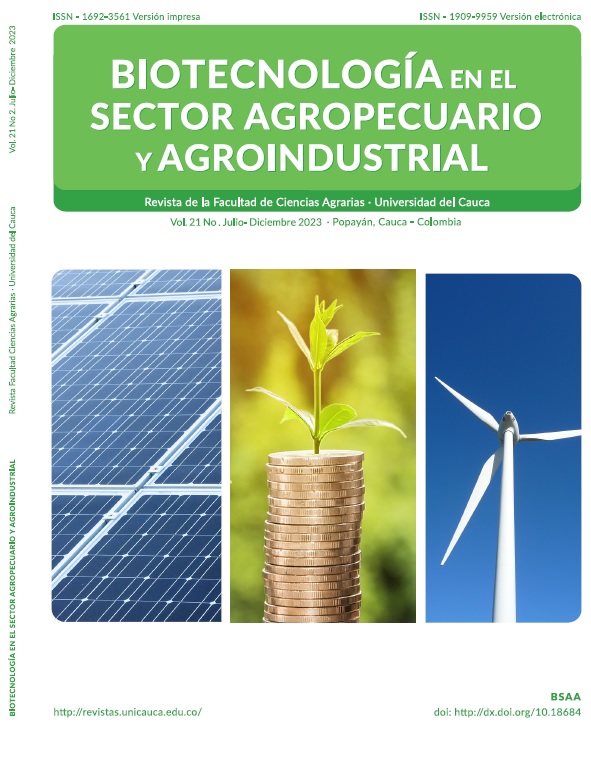Evaluación de la actividad inhibitoria de aceites esenciales contra bacterias patógenas presentes en trucha arcoíris (Oncorhynchus mykiss) responsables de enfermedades transmitidas por alimentos
Resumen
Esta investigación evaluó el efecto inhibidor de aceites esenciales (AE) de romero y orégano silvestre contra bacterias patógenas encontradas en trucha arcoiris, promotoras de enfermedades transmitidas por alimentos. Los AE fueron extraídos mediante fluidos supercríticos y se determinó su densidad, índice de refracción (IR), y compuestos orgánicos volátiles. Las bacterias se identificaron con el sistema Phoenix® y la susceptibilidad por Kirby-Bauer. Las actividades antimicrobianas y bactericida ejercida por AE contra S. aureus y B. cereus, se determinaron por microdilución. Como resultados se obtuvo una densidad de 0,89 y 0,93 g/cm3; IR de 1,46 y 1,40; humedad de 8,42 % y 8,34 % y rendimiento global de 2,42 % y 2,05 % para el aceite esencial de romero (AER) y el aceite esencial de orégano (AEO), respectivamente. La caracterización química por cromatografía de gases acoplada a espectrometría de masas determinó como compuestos representativos alcanfor (26,95 %) y trans-cariofileno (22,80 %) para el AER y timol (76,25 %) para el AEO. El AER ejerció un mayor efecto antimicrobiano y antibacteriano contra S. aureus (CMI y CMB= 28480 µg/mL) en comparación con el AEO, no obstante AEO presentó una mejor respuesta antimicrobiana (CMI= 44640 µg/mL) y antibacteriana (CMB=59520 µg/mL) contra B. cereus frente a AER, lo que sugiere un potencial efecto bioprotector de estos aceites esenciales como conservantes naturales de productos cárnicos.
Descargas
Disciplinas:
BiotecnologíaLenguajes:
EspañolReferencias bibliográficas
ACOSTA J.; ARANGO O.; ÁLVAREZ D.; HURTADO A. Actividad biocida del aceite esencial de lippia origanoides H.B.K sobre Phytophthora infestans (Mont.) de Bary. Información Tecnológica, v. 30, n. 6, 2019, p. 45–54.http://dx.doi.org/10.4067/S0718-07642019000600045
ACHOUR M.; MATEOS R.; BEN FREDJ M.; MTIRAOUI A.; BRAVO L.; SAGUEM S. A comprehensive characterisation of rosemary tea obtained from Rosmarinus officinalis L. collected in a sub-humid area of Tunisia. Phytochemical Analysis, v. 29, n. 1, 2018, p. 87–100.https://doi.org/10.1002/pca.2717
AL-HIJAZEEN M. Anti-bacterial effect of Rosmarinus officinalis Linn. extract and Origanum syriacum L. essential oil on survival and growth of total aerobic bacteria and Staphylococcus aureus using cooked chicken meat. Food Science Technology, v. 42, 2022, p. 1–9.https://doi.org/10.1590/fst.60720
ARGOTE-VEGA, F.; SUÁREZ-MONTENEGRO, Z.; TOVAR-DELGADO, M.; PÉREZ-ÁLVAREZ, J.; HURTADO-BENAVIDES, A.; DELGADO-OSPINA, J. Evaluation of the inability capacity of essential oils in Staphylococcus aureus and Escherichia coli. Biotecnología en el Sector Agropecuario y Agroindustrial, v. 15, 2017, p. 52–60. https://doi.org/10.18684/bsaa(v15)ediciónespecialn2.578
BAJ, T.; BARYLUK, A.; SIENIAWSKA, E. Application of mixture design for optimum antioxidant activity of mixtures of essential oils from Ocimum basilicum L., Origanum majorana L. and Rosmarinus officinalis L. Industrial Crops and Products, v. 115, 2018, p. 52–61.https://doi.org/10.1016/j.indcrop.2018.02.006
BOSKOVIC, M.; ZDRAVKOVIC, N.; IVANOVIC J.; JANJIC, J.; DJORDJEVIC, J.; STARCEVIC, M.; BALTIC, M. Antimicrobial activity of Thyme (Tymus vulgaris) and Oregano (Origanum vulgare) essential oils against some foodborne microorganisms. Procedia Food Science, v. 5, 2015, p. 18–21. https://doi.org/10.1016/j.profoo.2015.09.005
BUENO M. Compressed Fluids for Food By-product Biorefinery. In Nanotechnology in the Life Sciences (Springer, Cham), 2020, p. 219–238. https://doi.org/10.1007/978-3-030-44984-1_10
BURBANO-GALLARDO, E.; NIVIA-DUQUE, G.; IMUES-FIGUEROA, M.; GONZÁLEZ-LEGARDA, E.; GÓMEZ-DELGADO, M.; PANTOJA-DÍAZ, J. Efecto de cultivos piscícolas en los sedimentos y la proliferación de comunidades bacterianas nitrificantes en el lago Guamuez, Colombia. Ciencia & Tecnología Agropecuaria, v. 22, n. 2, 2021, p. 4-15. https://doi.org/10.21930/rcta.vol22_num2_art:1581
CENTRAL LECHERA ASTURIANA. (2021). Valores nutricionales Carnes, Pescados y Huevos. Carne, Fuente de Proteínas de Alto Valor Biológico. https://www.centrallecheraasturiana.es/nutricionysalud/nutricion/grupos-de-alimentos/carnes-pescados-y-huevos/ [consultado diciembre 11 de 2022].
CONDE-HERNÁNDEZ, L.; ESPINOSA-VICTORIA, J.; TREJO, A.; GUERRERO-BELTRÁN, J. CO2-supercritical extraction, hydrodistillation and steam distillation of essential oil of rosemary (Rosmarinus officinalis). Journal of Food Engineering, v. 200, 2017, p. 81–86.https://doi.org/10.1016/j.jfoodeng.2016.12.022
DOMÍNGUEZ, R.; PATEIRO, M.; GAGAOUA, M.; BARBA, F.; ZHANG, W.; LORENZO, J. A comprehensive review on lipid oxidation in meat and meat products. Antioxidants, v. 8, n. 10, 2019.https://doi.org/10.3390/antiox8100429
DUPAS, C.; MÉTOYER, B.; EL HATMI, H.; ADT, I.; MAHGOUB, S.; DUMAS, E. Plants: A natural solution to enhance raw milk cheese preservation?. Food Research International, v. 130, 2020, p. 108883.https://doi.org/10.1016/j.foodres.2019.108883
FAGUNDO-SIERRA, R.; CERROS-SANTOS, M.; PÉREZ-JÁUREQUI, J. Evaluación del instrumento automatizado Phoenix en la identificación y antibiograma de bacterias de origen clínico. Bioquimia, v. 32, n. 2, 2007, p. 39-48
FIEDLER, G.; SCHNEIDER, C.; IGBINOSA, E.; KABISCH, J.; BRINKS, E.; BECKER, B.; STOLL, D.; CHO, G.; HUCH, M.; FRANZ, C. Antibiotics resistance and toxin profiles of Bacillus cereus-group isolates from fresh vegetables from German retail markets. BMC Microbiology, v. 19, n. 1, 2019, p. 1–13.https://doi.org/10.1186/s12866-019-1632-2
GIACOMETTI, J.; BURSAĆ-KOVAČEVIĆ, D.; PUTNIK, P.; GABRIĆ, D.; BILUŠIĆ, T.; KREŠIĆ, G.; STULIĆ, V.; BARBA, F.; CHEMAT, F.; BARBOSA-CÁNOVAS, G.; REŽEK-JAMBRAK, A. Extraction of bioactive compounds and essential oils from mediterranean herbs by conventional and green innovative techniques: A review. Food Research International, v. 113, 2018, p. 245–262.https://doi.org/10.1016/j.foodres.2018.06.036
GYŐRI, E.; VARGA, A.; FÁBIÁN, I.; LÁZÁR I. Supercritical CO2 extraction and selective adsorption of aroma materials of selected spice plants in functionalized silica aerogels. Journal of Supercrit Fluids, v. 148, 2019, p. 16–23. https://doi.org/10.1016/j.supflu.2019.02.025
INSTITUTO COLOMBIANO DE NORMAS TÉCNICAS Y CERTIFICACION (ICONTEC).2016. Grasas y aceites animales y vegetales. Método de la determinación de la densidad (masa por volumen convencional). Disponible en: https://tienda.icontec.org/gp-grasas-y-aceites-animales-y-vegetales-metodo-de-la-determinacion-de-la-densidad-masa-por-volumen-convencional-ntc336-2016 [Consultado agosto 20 de 2022].
INSTITUTO COLOMBIANO DE NORMAS TÉCNICAS Y CERTIFICACION (ICONTEC).2019. Grasas y aceites animales y vegetales. Método de la determinación del índice de refracción. Disponible en: https://tienda.icontec.org/gp-grasas-y-aceites-animales-y-vegetales-determinacion-del-indice-de-refraccion-ntc289-2019 [Consultado agosto 20 de 2022].
(ITALIA). ORGANIZACIÓN DE LAS NACIONES UNIDAS PARA LA AGRICULTURA Y LA ALIMENTACIÓN (FAO). El estado mundial de la agricultura y la alimentación. Progresos en la lucha contra la pérdida y el desperdicio de alimentos. 2019. ISBN 978-92-5-131854-6
(ITALIA). ORGANIZACIÓN DE LAS NACIONES UNIDAS PARA LA AGRICULTURA Y LA ALIMENTACIÓN (FAO). The state of world fisheries and aquaculture 2020. Sustainability in action. 2020. https://doi.org/10.4060/ca9229en
JOVANOVIC, J.; ORNELIS, V.; MADDER, A.; RAJKOVIC, A. Bacillus cereus food intoxication and toxicoinfection. Comprehensive Reviews in Food Science and Food Safety, v. 20, n. 4, 2021, p. 3719–3761. https://doi.org/10.1111/1541-4337.12785
LEAL, A.; BRAGA, A.; DE ARAÚJO, B.; RODRIGUES, A.; DE CARVALHO, T. Antimicrobial action of essential oil of Lippia origanoides H.B.K. Journal of Clinical Microbiology and Biochemical Technology, v. 5, n. 1, 2019, p. 007–012. https://dx.doi.org/10.17352/jcmbt.000032
OU, C.; SHANG, D.; YANG, J.; CHEN, B.; CHANG, J.; JIN, F.; SHI, C. Prevalence of multidrug-resistant Staphylococcus aureus isolates with strong biofilm formation ability among animal-based food in Shanghai. Food Control, vol. 112, 2020, p. 107106.https://doi.org/10.1016/j.foodcont.2020.107106
PISOSCHI, A.; POP, A.; GEORGESCU, C.; TURCUŞ, V.; OLAH, N.; MATHE, E. An overview of natural antimicrobials role in food. European Journal of Medicinal Chemistry, v. 143, 2018, p. 922–935. https://doi.org/10.1016/j.ejmech.2017.11.095
PUTNIK, P.; GABRIĆ, D.; ROOHINEJAD, S.; BARBA, F.; GRANATO, D.; MALLIKARJUNAN, K.; LORENZO, J.; BURSAĆ-KOVAČEVIĆ, D. An overview of organosulfur compounds from Allium spp.: From processing and preservation to evaluation of their bioavailability, antimicrobial, and anti-inflammatory properties. Food Chemistry, v. 276, 2019, p. 680–691.https://doi.org/10.1016/j.foodchem.2018.10.068
RASIA, M.; CASTAGNINI, J.; PEREYRA, F.; CAPODOGLIO, D.; GERARD, J.; SAN MIGUEL, S.; PAGANI, C. Estudio de emulsiones pickering para la microencapsulación de aceites esenciales cítricos y su estabilización por liofilización. Ciencia, Docencia y Tecnología, v. 9, n. 9, 2019, p. 94–110.https://pcient.uner.edu.ar/index.php/Scdyt/article/view/661
RONG, D.; WU, Q.; XU, M.; ZHANG, J.; YU, S. Prevalence, virulence genes, antimicrobial susceptibility, and genetic diversity of Staphylococcus aureus from retail aquatic products in China. Frontiers Microbiology, v. 8, 2017, p. 1–10.https://doi.org/10.3389/fmicb.2017.00714
SANTOMAURO, F.; SACCO, C.; DONATO, R.; BELLUMORI, M.; INNOCENTI, M.; MULINACCI, N.; The antimicrobial effects of three phenolic extracts from Rosmarinus officinalis L., Vitis vinifera L. and Polygonum cuspidatum L. on food pathogens. Natural Products Research, v. 32, n. 22, 2018, p. 2639–2645. https://doi.org/10.1080/14786419.2017.1375920
SUÁREZ, K.; MELO, D.; FLÓREZ, M.; MACÍAS, J.; RÍOS L. Aporte socioeconómico y valorización de residuos de trucha en El Encano (Municipio de Pasto). Semestre Económico, v. 23, n. 55, 2020, p.331-352.https://doi.org/10.22395/seec.v23n55a15
SUÁREZ-MONTENEGRO, Z.; ÁLVAREZ-RIVERA, G.; MENDIOLA, J.; IBÁÑEZ, E.; CIFUENTES, A. Extraction and mass spectrometric characterization of terpenes recovered from olive leaves using a new adsorbent-assisted supercritical CO2 process. Foods, v. 10, 2021, p. 1301. https://doi.org/10.3390/foods10061301
SUCASAIRE, J. Orientaciones para la selección y el cálculo del tamaño de la muestra en investigación. 2022. In Paper Knowledge . Toward a Media History of Documents.http://repositorio.concytec.gob.pe/bitstream/20.500.12390/3096/1/Orientaciones_para_seleccion_y_calculo_del_tamaño_de_muestra_de_investigacion
SUEISHI, Y.; SUE, M.; MASAMOTO, H. Seasonal variations of oxygen radical scavenging ability in rosemary leaf extract. Food Chemistry, v. 245, 2018, p. 270–274. https://doi.org/10.1016/j.foodchem.2017.10.085
WORLD HEALT ORGANIZATION (WH0). Estimating the burden of foodborne diseases: a practical handbook for countries. 2021. In World Health Organization. https://www.who.int/publications/i/item/9789240012264
YOUSEFI, M.; RAHIMI-NASRABADI, M.; POURMORTAZAVI, S.; WYSOKOWSKI, M.; JESIONOWSKI, T.; EHRLICH, H.; MIRSADEGHI, S. Supercritical fluid extraction of essential oils. TrAC - Trends in Analytical Chemistry, v. 118, 2019, p. 182–193.https://doi.org/10.1016/j.trac.2019.05.038
Derechos de autor 2023 Universidad del Cauca

Esta obra está bajo una licencia internacional Creative Commons Atribución-NoComercial-SinDerivadas 4.0.


 Español
Español Inglés
Inglés





















.png)



